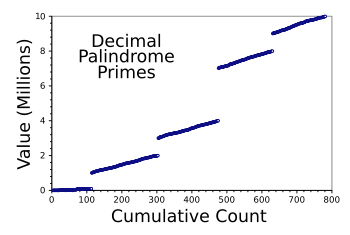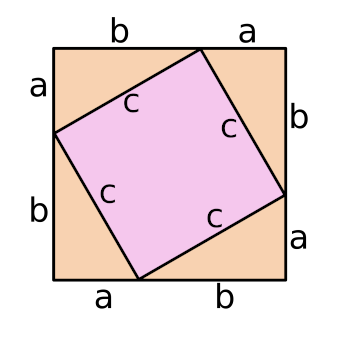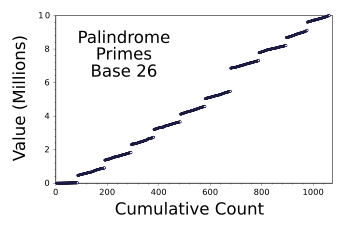Palindrome Numbers
January 31, 2022
Desk Set is an enjoyable 1957
film directed by
Walter Lang and staring
Spencer Tracy and
Katharine Hepburn. The
plot of this film is based on a
fanciful depiction of
mainframe computers and their operation in the late
1950s. This computer, called EMARAC (for Electromagnetic Memory and Research Arithmetical Calculator), could do
natural language processing, and it had a
database that's equivalent to the
Internet of today.
Tracy is portrayed as a
methods engineer, but he actually plays something like a
computer scientist who's been assigned to computerize a
library.
Employees resist deployment of the computer, since they
believe that it's intended to replace them, but that didn't happen. The film
acknowledges the assistance of the
International Business Machines Corporation in its
production, and some
critics have called the film an IBM
propaganda piece with the message that computers won't take your job.
For no apparent reason, Tracy gives Hepburn an
IQ test during a
luncheon meeting. Their conversation features two
palindromes. Palindromes are a
word or
phrase that's the same whether
read forwards or backwards. One is
Adam's supposed first words to
Eve,
Madam, I'm Adam. The other is something
Napoleon might have said,
Able was I ere I saw Elba,
Elba being the place of Napoleon's first
exile from 1814 to 1815.
It's not surprising that there are an
infinite number of
palindromic numbers, and creating such numbers is all too easy. It's more fun finding
prime numbers that are also palindromes. These
palindrome primes are
integer sequence A002385 of the
On-Line Encyclopedia of Integer Sequences. A simple example is the number eleven; a more complex one is 17471. Palindromic primes are found in
number bases other than
base 10 (decimal). The prime number 1991 is also a palindrome when written in
hexadecimal, 7C7.
Just below one million (which is obviously not a palindrome) we have 98689 as a palindrome prime; or, the hexadecimal palindrome prime F383F (997439 in decimal). These are very easily generated in a
high-level language, and my
PHP and C language
programs to calculate palindrome primes can be found
here.

graph of decimal palindrome primes less than ten million.
There are 781 decimal palindrome primes up to 9,989,899.
The gaps are a consequence of the fact that every palindrome with an even number of digits is divisible by 11, so these numbers are not prime.
(Data from my C language program, graphed using Gnumeric. Click for larger image.)
After discovering a
mathematical concept,
mathematicians search for possible variants. Such is the case for the
Pythagorean theorem, for which there are more than 370
proofs.[2] My favorite, perhaps because of its simplicity, is shown figure. It's credited to the
12th century Hindu mathematician,
Bhaskara (1114-1185). One proof, thought to have been created by
Leonardo da Vinci (1452-1519), was actually authored in 1772 by
German physicist,
Johannes Tobias Mayer (1752-1830).[3]

A proof of the Pythagorean theorem by Bhaskara.
In Bhaskara's proof, the area of the inner square is c2, the area of the outer square is (a+b)2, and the area of each triangle is (1/2)(ab).
U.S. President, James Garfield (1831-1881), created a novel proof when he was a member of the U.S. House of Representatives. His proof equates the area of a trapezoid to the combined area of its contained triangles.
(Drawing by the author using Inkscape. Click for larger image.)
Mathematician,
Daniel Tsai, has examined a variant of palindrome numbers that he calls
v-palindromes.[4] The numbers themselves are not palindromes; rather, the palindrome property arises from the fact that these numbers and the numbers formed by reversing their digits have the same sum of their
factors. For example,
198 = 2 · 3 · 2 · 11
2 + 3 + 2 + 11 = 18
891 = 3 · 4 · 11
3 + 4 + 11 = 18
Tsai writes that he first discovered his
v-palindromes in 2007, when he was just 15 years old.[4] His first
publication on the topic was in October, 2018, in Sṓgaku Seminar magazine, which he describes as the
American Mathematical Monthly of
Japan.[5] This paper also proved that there are infinitely many
v-palindromes in base ten.[4] This is a simple proof in which it is shown that numbers with any number of nines in the middle, are v-palindromes in base ten (e.g., 18, 198, 1998).[4] Furthermore, all numbers with any number of 18's repeatedly
concatenated are v-palindromes in base ten (e.g., 18, 1818, 181818).[4]
The smallest v-palindrome for number bases to 16
| Number Base |
Smallest v-palindrome
(decimal equivalent) |
| 2 |
175 |
| 3 |
1280 |
| 4 |
6 |
| 5 |
288 |
| 6 |
10 |
| 7 |
731 |
| 8 |
14 |
| 9 |
93 |
| 10 |
18 |
| 11 |
135 |
| 12 |
22 |
| 13 |
63 |
| 14 |
26 |
| 15 |
291 |
| 16 |
109 |
I wrote about
base 26 (hexavigesimal) numbers in a
recent article (Shakespearean Monkeys, September 20, 2021). This is an interesting number base, since there are 26
lower case characters in the
English alphabet. It's possible to
encode a
letter as base 26 numbers, and this was the basis of an early
Internet cryptography joke.
ROT13 is a
Caesar cipher in which characters are
transposed by 13 places; thus,
a becomes
n, etc.. ROT13 has the property that doing this operation again restores the original message. ROT13 is used not as a secure
cipher, but as a simple means of giving/retrieving "
spoiler"
information, such as the answer to a
puzzle, and there are
browser extensions for ROT13.
You can
confuse,
amuse, and
impress your
friends by including the number, 14841, in your messages. The decimal number 14841, a
composite number (3 x 3 x 17 x 97), is "
lol" in base 26. I created a
C language program to search the first ten million numbers for base 26 palindrome primes. You can get the
source code here. A list of the numbers is found
here. The occurrence of these palindrome primes is shown in the following graph. Compare this gap pattern with that of the decimal palindrome primes shown above.

Graph of hexavigesimal (Base 26) palindrome primes less than ten million.
There are 1062 hexavigesimal palindrome primes up to 9998633 (lmmml).
(Data from my C language program, graphed using Gnumeric. Click for larger image.)
References:
- Desk Set (1957) Walter Lang, Director, on the Internet Movie Database.
- Elisha Scott Loomis, "The Pythagorean proposition: its demonstrations analyzed and classified, and bibliography of sources for data of the four kinds of proofs," Education Resources Information Center. Institute of Education Sciences (IES) of the U.S. Department of Education (1940); reprinted in 1968 by National Council of Teachers of Mathematics (310 page PDF File).
- Franz Lemmermeyer, "On Leonardo da Vinci's proof of the Theorem of Pythagoras," arXiv, January 15, 2014.
- Daniel Tsai, "v-palindromes: an analogy to the palindromes," arXiv, November 17, 2021.
- Tsai, D. (2018). Natural numbers satisfying an unusual property. Sṓgaku Seminar, vol. 57, no. 11), pp. 35-36 (in Japanese).
Linked Keywords: Desk Set; film; director; Walter Lang; Spencer Tracy; Katharine Hepburn; plot (narrative); fantasy; fanciful depiction; mainframe computer; 1950s; natural language processing; database; Internet; methods engineering; methods engineer; computer scientist; library; employment; employees; belief; believe; acknowledgment (creative arts and sciences); IBM; International Business Machines Corporation; production (filmmaking); criticism; critic; propaganda; intelligence quotient; IQ test; lunch; luncheon; meeting; palindrome; word; phrase; reading (process); read; Adam; Eve; Napoleon; Elba; exile; infinity; infinite number; palindromic number; prime number; palindromic prime; palindrome prime; integer sequence A002385; On-Line Encyclopedia of Integer Sequences; radix; number base; base 10 (decimal); hexadecimal; high-level programming language; PHP; source code; program; graph of decimal palindrome primes less than ten million; Cartesian coordinate system; graph; decimal; gap (chart pattern); parity (mathematics); even number; numerical digit; division (mathematics); divisible; Gnumeric; mathematics; mathematical; concept; mathematician; Pythagorean theorem; mathematical proof; 12th century; Hindu; Bhaskara (1114-1185); Leonardo da Vinci (1452-1519); German; physicist; Johannes Tobias Mayer (1752-1830); proof of the Pythagorean theorem by Bhaskara; area; square; triangle; President of the United States; James Garfield (1831-1881); United States House of Representatives; trapezoid; Inkscape; Daniel Tsai; factorization; factor; scientific literature; publication; American Mathematical Monthly; Japan; concatenation; concatenate; letter case; lower case; alphabet; character; English language; encryption; encode; letter (message); Internet; cryptography; joke; ROT13; Caesar cipher; transposition cipher; transpose; spoiler (media); information; puzzle; browser extension; confusion; confuse; amusement; amuse; impress; friendship; friend; composite number; LOL; lol; C language program; source code; palindrome26.c; graph of hexavigesimal (Base 26) palindrome primes less than ten million.